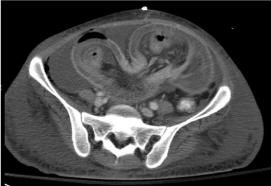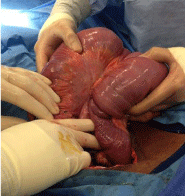Case Report
Intussusception in Patients with Crohn’s Disease: Is Resection Always Mandated?
Scott G Blair1*, Celia Y Quang1, Jon D Simmons1, Leander M Grimm Jr2, Paul F Rider2 and William O Richards1
1Department of Surgery, University of South Alabama Medical Center, USA
2Department of Colorectal Surgery, University of South Alabama Medical Center, USA
*Corresponding author: Scott G Blair, Department of Surgery, University of South Alabama, 2451 Fillingim St., Suite10-I, Mobile, AL 36617-2293, USA
Published: 20 Apr, 2017
Cite this article as: Blair SG, Quang CY, Simmons JD,
Grimm Jr LM, Rider PF, Richards
WO. Intussusception in Patients with
Crohn’s Disease: Is Resection Always
Mandated?. Clin Surg. 2017; 2: 1417.
Abstract
Objective: The objective is to present an interesting case of intussusception in an adult with Crohn’s
Disease and do a subsequent review of the literature for the management of this difficult patient
population.
Background: Intussusception is rare in the adult population and unlike in children, it is usually
associated with a malignant lesion. For these reasons, adult intussusception has historically mandated
operative exploration. However, adult patients with Crohn’s disease (CD) are an exception as they
often have a non-malignant etiology of intussusception. Due to the complexity of patients with CD
and the high likelihood of requiring further bowel resections that may eventually cause short bowel
syndrome, preventing any unnecessary bowel resection should be a high priority in this patient
population.
Conclusion: Intussusception occurs rarely in adults with CD. While the patient will need evaluation
for an underlying carcinoma, patients with CD without an obvious lead point can be treated with
reduction of the intussusception without resection.
Introduction
Intussusception is rare in the adult population and unlike in children, it is usually associated with a malignant lesion. For these reasons, adult intussusception has historically mandated operative exploration. However, adult patients with Crohn’s disease (CD) are an exception as they often have a non-malignant etiology of intussusception. Due to the complexity of patients with CD and the high likelihood of requiring further bowel resections that may eventually cause short bowel syndrome, preventing any unnecessary bowel resection should be a high priority in this patient population. Here we present a case report and subsequent review of the literature of a patient with a past medical history of CD that developed a long segment of intussusception, which was treated without bowel resection.
Case Presentation
We present a 33-year old female with active CD was found to have pneumoperitoneum on computed tomography (CT). She underwent an exploratory laparotomy and right hemicolectomy for a perforation in the terminal ileum secondary to active CD. There were no signs of inflammation upon examination of the remaining bowel. The patient displayed a prolonged ileus. A subsequent CT scan was performed revealing a long segment of intussusception not involving the anastomosis (Figure 1). Exploratory laparotomy was performed where an edematous segment of small bowel containing approximately two feet of intussusceptum was encountered (Figure 2). Manual reduction of the intussusception was performed and no pathological lead point could be identified. The bowel appeared to be free of gross inflammatory disease. The patient recovered normally and was subsequently discharged. At three years of follow-up, the patient had no further episodes of intussusception and no evidence of malignancy.
Discussion
Intussusception is the leading cause of intestinal obstruction in children and the second
most common surgical emergency, but it is a relatively rare cause of intestinal obstruction in the
adult population. In the pediatric population intussusception is idiopathic and benign in 90% of
cases, while in the adult population a pathologic cause can be found in 90% of cases. The overall malignancy rate in the adult population with intussusception is 46%,
with the majority of those occurring in the large bowel as a primary
malignancy. A small bowel intussusception is much less frequently
associated with a malignant cause, but if one is found it is usually due
to a metastatic lesion [1].
Resection of intussusception has historically been the
recommendation in the adult population due to the high likelihood
of the presence of a malignancy [2]. Resection is generally performed
by removing both the intussusception and intussusceptum without
reduction to avoid reperfusion of necrotic tissue and the resulting
cytokine release. With the widespread use of CT scanning there has
been a paradigm shift in the literature with more recommending
conservative management when possible or selective resection if a
pathologic lesion is found [2]. Many of these diagnoses found on CT
scan are transient asymptomatic intussusceptions only discovered on
imaging studies. Intussusception found on imaging can be managed
conservatively without the need for celiotomy in some cases [3]. In
the adult patient without CD with symptomatic intussusception most
would still advocate for primary resection over operative reduction
due to the risk of malignancy.
Crohn’s Disease is a chronic granulomatous inflammatory
disease that may involve any part of the alimentary tract, but is
most frequently found in the terminal ileum. These granulomas can
be either necrotizing or non-necorotizing. Over time necrotizing
granulomas lead to small ulcerations of the affected bowel causing
scarring and thickening of the segment of bowel. Necrotizing
granulomas and bowel wall thickening as well as submucosal edema,
bowel wall abscesses, and pseudopolyps are some of the hypotheses of
why intussusception is seen most frequently in the ileum in patients
with CD. In our patient it was submucosal edema of the small bowel
that resulted in the intussusception. For this reason, reduction
without resection was the intervention that we chose to help preserve
bowel length.
Approximately 70% of patients with CD will require operative
intervention due to their disease at some point during their life span,
and of these patients another 50% will require a second operation.
In CD a more conservative approach is indicated whenever possible,
even in the symptomatic patient with intussusception. Repeated
resection in this patient population puts them at an increased risk
for developing short bowel syndrome. In patients with CD operative
reduction is preferred over primary resection in the absence of a
pathologic lesion concerning for malignancy, those requiring a
massive length of resection, or in the absence of strangulation or
ischemia. The intussusception is usually a result of the patient’s
disease rather than a malignancy and they are better served with
conservation of bowel length.
Postoperatively patients who undergo operative reduction
without resection do warrant further workup. Due to the small but
very real risk of malignancy as the cause of the lead point these
patients should undergo the appropriate endoscopic evaluation [4].
Figure 1
Figure 2
Conclusion
Intussusception occurs rarely in adults with CD. While the patient will need evaluation for an underlying carcinoma, patients with CD without an obvious lead point can be treated with reduction of the intussusception without resection.
References
- Azar T, Berger DL. Adult intussusception. Ann Surg. 1997;226(2):134-8.
- Erkan N, Haciyanli M, Yildirim M, Sayhan H, Vardar E, Polat AF. Intussusception in adults: an unusual and challenging condition for surgeons. Int J Colorectal Dis. 2005;20(5):452-6.
- Lvoff N, Breiman RS, Coakley FV, Lu Y, Warren RS. Distinguishing features of self-limiting adult small bowel intussusception indentified at CT. Radiology. 2003;227(1):68-72.
- Canavan C, Abrams KR, Mayberry J. Meta-analysis: colorectal and small bowel cancer risk in patients with Crohn's disease. Aliment Pharmacol Ther. 2006;23(8):1097-104.


